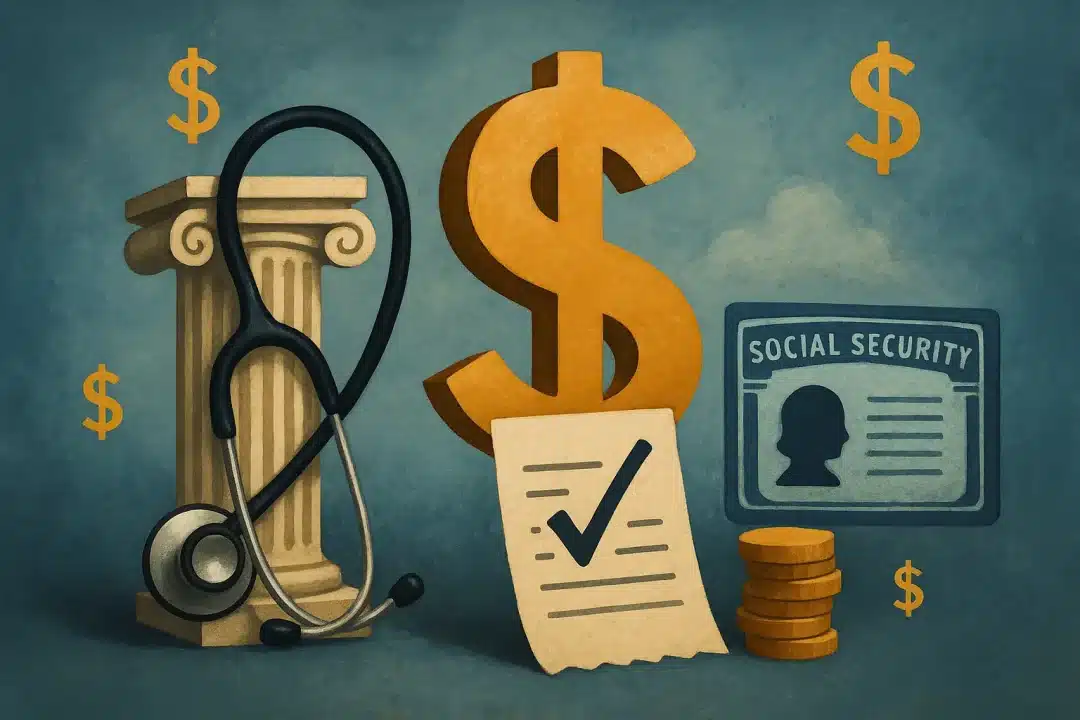
The 119th Congress passed the One Big Beautiful Bill in early-July, and President Donald Trump signed it into law shortly after, enacting a comprehensive legislative package focused on tax reform, health care restructuring, and entitlement policy revisions.
While the bill passed in 2025, its many provisions take effect on different timelines, depending on the agency, program, or benefit involved. Here’s a breakdown of when the most impactful money-related provisions—those affecting Social Security, Medicare, Medicaid, the IRS, and health care—begin to take effect.
IRS and federal tax provisions begin January 1, 2025
One of the biggest immediate impacts of the bill comes in the form of tax relief and simplification.
Key 2025 tax code changes include:
- Enhanced standard deduction: Lawmakers increased the standard deduction for all filers and tied it more aggressively to inflation.
- Middle-class tax cuts: The bill permanently extends reduced income tax rates for most income brackets that previous tax legislation had set to expire.
- “No tax on tips” and “No tax on overtime” rules: These provisions exempt most service and hourly workers from paying federal income taxes on reported tip income or overtime pay.
- Small business incentives: Full expensing of certain equipment and R&D costs begins in the 2025 tax year, meant to encourage domestic investment and manufacturing.
- IRS Direct File: The IRS plans to launch a federally managed, no-cost e-filing platform before the 2026 filing season, allowing qualifying individuals to file their taxes directly.
These provisions, largely covered under Title VII of the bill, are effective for the 2025 tax year, which means most Americans will see these benefits reflected when they file in early 2026.
Medicare reforms take effect in 2025 and 2026
The law includes a significant overhaul of Medicare’s cost structure and payment policies, especially for prescription drugs.
Starting January 1, 2025:
- Medicare Part D will implement a $2,000 annual cap on out-of-pocket spending, providing relief to seniors with high prescription costs.
- Insulin cost cap: Insulin costs for Medicare enrollees will be capped at $35/month.
- Government negotiation: The Department of Health and Human Services will begin negotiating prices for select high-cost prescription drugs under Medicare.
- Temporary boost to physician payment rates to ensure access during the early implementation phase, especially in rural areas.
In 2026:
- Medicare will release an expanded drug formulary for Medicare Advantage plans.
- Medicare will phase in additional restrictions on orphan drugs in the price negotiation program.
Medicaid changes roll out gradually through 2026
The bill introduces new guardrails, eligibility verification tools, and state incentives aimed at reducing fraud while expanding coverage access.
Notable Medicaid provisions:
- Moratoriums on restrictive rules: Several federal rules that made Medicaid enrollment harder for seniors and disabled individuals are paused through 2026.
- Coverage for home and community-based services will be expanded, with funding tied to state compliance by mid-2026.
- Eligibility redetermination mandates: States must conduct periodic redeterminations and remove deceased enrollees from the system.
- Community engagement requirements: Non-disabled, childless adults may be required to work or volunteer in exchange for coverage beginning in 2027, depending on the state.
All state plans must meet new eligibility, reporting, and fraud prevention standards no later than December 31, 2026.
Social Security changes tied to transparency and modernization
The bill doesn’t change benefit formulas but mandates several administrative reforms to the Social Security Administration.
Effective by June 2026:
- Improved online access to benefit estimates: SSA must offer a clear breakdown of retirement, disability, and survivor benefits via its website.
- Updated communication tools: The Social Security Administration must report notices and wait times quarterly and meet new minimum standards for call center wait times.
- Modernization of internal systems: The bill allocates funding to improve processing of disability and survivor claims starting in fiscal year 2025.
Health tax credits and ACA subsidies already extended in 2024
Before Congress fully passed the bill, lawmakers retroactively applied select provisions to the 2024 coverage year:
- Premium subsidies for Affordable Care Act plans were extended through 2026, preventing premium hikes for middle-income enrollees.
- Bronze and catastrophic health plans were made eligible for Health Savings Accounts (HSAs).
- Direct primary care arrangements can now be treated as deductible medical expenses, broadening tax benefits for nontraditional health care options.
These measures were part of the Health Tax and Choice reforms under Subtitle B, Chapter 3.
Timeline summary of major provisions
| Area | Effective Date | Details |
|---|---|---|
| Income tax reform | Jan. 1, 2025 | Middle-class cuts, deduction increases, no tax on tips/overtime |
| Medicare drug cap | Jan. 1, 2025 | $2,000 annual cap; insulin at $35/month |
| IRS Direct File rollout | Late 2025 – Early 2026 | Free federal tax filing program |
| Medicaid expansion rules | July–Dec. 2026 | Eligibility, fraud prevention, and HCBS enhancements |
| SSA modernization | By June 2026 | Online tools and transparency measures |
| ACA subsidies extended | Retroactive to Jan. 1, 2024 | Continued premium assistance for exchange enrollees |
What happens next?
Agencies like the IRS, CMS, and SSA are expected to publish implementation guidance through late 2025 and early 2026. While some Americans will see immediate benefits—especially on taxes and Medicare—others, particularly Medicaid recipients and lower-income populations, may not feel the impact until late 2026.
Lawmakers have indicated additional technical corrections or follow-up legislation could be introduced to address gaps or delays in implementation.
